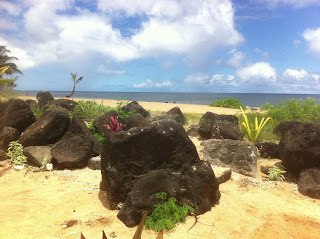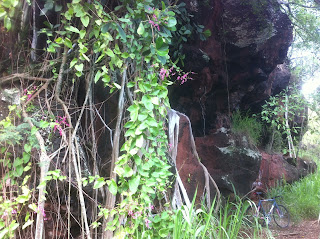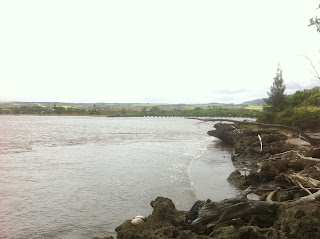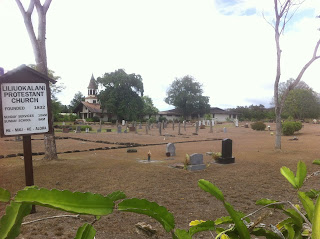Back in Waialua for a discovery ride on my bike!
At the bottom of the winding section into Waialua, behind the general store, alongside Kaukohahua stream, was a heiau and akua stone related to Pele legends. The area was also used as a cemetery for Hawaiians toward the late 1800's. A grove was planted over it and overgrowth hides any sign of the site #203 in McAllister's survey of Oahu.
A large akua stone was located in the water, at the mouth of Anahulu River. Which had threatened to damage glass bottom boats crossing over it during low tides. So it was moved or taken out of the water...
I have no idea which one it is or If it's even still in the area.
Just outside of Haleiwa town, Kawailoa is Oku'a pond. Laniwahine was the mo'o woman of this area. Mullet were said to be of a different color here. In the story of Oahunui, the ali'i that acquired a taste for human flesh by his cannibal neighbors living near Helemano. Sent his sisters husband, Lehuanui to gather fish for him. While Oahunui slain and ate his niece and nephew....
Further north, a bit past Punanui Point. on the mauka side of Kamehameha Hwy. Are a few cattle pens that mark a highly concentrated area of old stone structures. This stone is what I suspect to be the Frog stone that was pointed out by locals to the first ranch owners as a sacred Akua stone. Frogs must have been a somewhat later term to describe this stone. Since frogs were virtually unknown to the islands long ago. Although it does help when trying to locate it presently. It appears to have more of a lantern platform. Like others known around the island.
Just a few yards toward Waimea are more stone structures that could be mistaken as a pile of stones. Upon closer inspection they are all arranged in a peculiar order. Many stone walls are scattered throughout a small rise on the plain. Some enclosing smaller sections and others gathered into a flat alter like platform toward the center. Cow dung littered the area and now no one would suspect this to be Kahokuwelowelo Heiau (*update this is suspected to be Iliilikea Heiau as Jan Becket mentioned). One of the first indicators to a native Hawaiian that you were entering the domain of the Kahuna class. Commoners never approached this area and further toward Waimea. More and more structures designed for the use of Kahuna are to be found...
This stone seemed like the center of the Heiau and may have been an alter of some sort.
Heiau for Kahuna always need a fresh water source and this one would have had one here at this well.
It was about a 30ft drop to the bottom. Which looked as green as a rainforest in this otherwise dry area at the surface.
I finally made my way to Waimea, but not after trying to find Kupopolo Heiau. Kaopulupulu, the last kahuna of the land of Oahu, was said to have been based at that heiau. He also stopped over at Kahokuwelowelo before his doomed journey to meet with Kahahana. Which would lead to the death of Kaopulupulu and his son. By the command of the last Oahu Ali'i Kahahana. Resulting in the Oahu dynasty to lose a connection to the land.
I could not find a trail that would lead me to where I knew the Heiau was. I did find another path that took me toward some burial caves just outside of Waimea Bay mistakenly. This one was littered with broken glass and even had a fluorescent Hi Viz shirt hanging on the wall...
I noticed a barrier up on a higher cliff section just up the roots of the tree. I tried to climb it and take a better look. To what opened up to what was about a 12ft x 12ft outcropping. Just then I figured if I fell and knocked my head. I'd probably never be found by anyone for some time, and decided to climb back down.
Rock walls hidden in the over growth.
I saw an old image of this cave where a haole man is sitting inside and carrying two skulls. Another image I found explained that it was sealed with bones inside. I'm unsure if all of the bones in other caves were stored in here.
This cave is right next door to the last. Also containing broken glass but also very old looking matting on the cave floor and some woven fabric of modern design.
The path switchbacks uphill after the last two caves but I was hoping it would eventually lead downhill to the Heiau. I stood at the edge of the cliff and noticed the platform I was standing on was also a very high rock wall...
In the distance down the cliff. I finally notice Kupolopolo Heiau. Well preserved and hidden in the brush. I plan to find a respectful way to approach the Heiau. Without exposing it to over use.
Late afternoon and I finally get to Waimea Bay. The last time I rode here I saw a man landscaping this outcrop and told him I would research the area and tell him the name of the pohaku within it. He wasn't there this time but the area looked better and better every time I come back.
This is suspected to be a fishing shrine ko'a named Kehuohapu'u and it formally enclosed an akua stone named Kaneaukai. A stone in which its name is also mentioned at the first heiau in this post all the way back at the general store in Waialua town...
I must admit after a couple of "refreshments" at Waimea and a poke bowl from Foodland. I didn't feel like riding back up to Wahiawa. I jumped on the bus and made sure to get off at Mililani so I could bomb down the gulch and out into the comfort of my side of the island again.
While one the bus thinking about a bunch of places I still have yet to visit somehow. My mind drifted back toward the Ali'i Ma'ilikukahi. He was credited for solidifying the land divisions of districts and was said to be able to point out important features on the entire island. His time and his offspring were marked by justly and peaceful rule. Which allowed Oahu to almost pinnacle in abundance. Compared to the past and even future rulers. Born at Kukaniloko, crowned at Kapukapuakea, and later moving the kingdom to what is now known as Waikiki. He was a true product of Oahu.
Here just before the final down hill to my district. In Kipapa, Ma'ilikukahi defended Oahu. Against a raid from the island of Hawaii. Intending on claiming some battle fame or "cashing in" on Oahu's newly established abundance. Ma'ilikukahi utterly destroyed all involved in the attempt. Making land marks with the slain and naming them after their leaders. Proving to the other islands rival chiefs that Oahu was well organized and powerful during his time...



















































